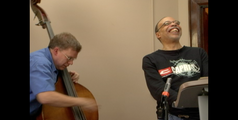Miya Masaoka
MIYA MASAOKA
Miya Masaoka, musician, sound artist, and composer, is one of just a handful of musicians who have succeeded in introducing the 17-string Japanese koto zither to the world of avant-garde music. She first came to recognition collaborating with artists as diverse as Pharoah Sanders, Fred Frith and Steve Coleman, and is regarded as a world-renowned performer. Highly esteemed for her abundantly creative and improvisational technique, and a sensibility that combines experimental Western approaches with the tradition of the koto, Masaoka’s pioneering performance work cannot be easily pigeonholed into any single genre. Her work draws from the collision of tradition with the modern, the rupture of a sonic past with the myriad possibilities of the “new.” Such merging of the past and present is displayed in her performances where electronic triggers allow for additional laser beam “strings” to hover over the koto. Her impressive catalogue of diverse compositions includes work for field recordings, laptops, and videos, and she has written scores for ensembles, chamber orchestras, and mixed choirs. With creative veracity and experimental inquiry her pieces have investigated the sound and movement of insects (she has orchestrated Madagascar hissing cockroaches and bees as they crawl across her body), as well as the physiological responses of plants, the human brain, and her own body. Within these varied contexts her performative sound work investigates (often with a high level of confluence) the interactive, collaborative aspects of sound, improvisation, nature, society and the contemporary expression of Japanese gagaku aural gesturalism: a way of presenting yourself, expressing the music through your posture. Masaoka’s work has been presented in Japan, Canada, and Europe, and she has toured to India six times. In 2012, Masaoka was one of ICASP’s Improvisers-in-Residence.
Mark Laver is an ICASP Post-Doctoral Fellow, based at the University of Guelph, researching intersections between musical improvisation and capitalist economics and ideologies. His work is forthcoming or published in several academic and non-academic journals, including Popular Music, Critical Studies in Improvisation, SAGAR, Discourses, The Recorder, and Canadian Musician. He completed his PhD in Ethnomusicology at the University of Toronto. His forthcoming book project, Jazzvertise: Music, Marketing, and Meaning, focuses on the use of jazz in advertising. He is also currently completing a special issue as a guest editor with Ajay Heble in Critical Studies in Improvisation on Ethics and the Improvising Business. Mark is a busy working saxophonist, and has performed with leading jazz and improvising musicians such as Lee Konitz, Phil Nimmons, NEXUS, Dong Won Kim, and Eddie Prévost.
In this month’s Oral History, Mark Laver sits down with Miya Masaoka and discusses her process as an intermedial artist, past and present projects, and the tensions between improvisation and composition.
Improvising a Tradition: Miya Masaoka in Conversation with Mark Laver
A full transcript of the interview is available here.
Also, check this video of ICASP researchers and improvisers Joe Sorbara, Mark Laver, and Amadeo Ventura performing with Miya Masaoka during her Improviser-in-Residence residency for an impromptu musical “intervention” at Planet Bean Cafe in downtown Guelph.


